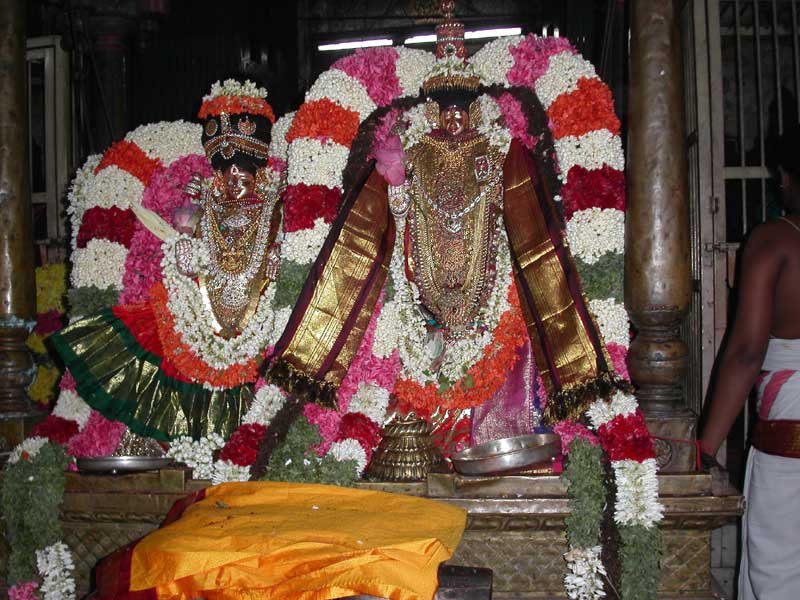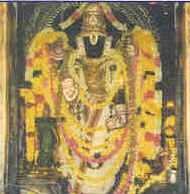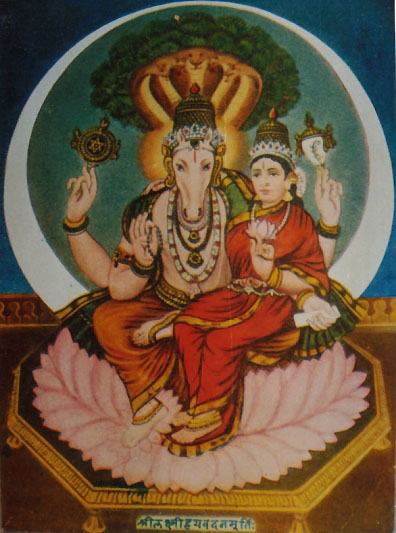artitarthaparidana dikshitam |
Sarva bhutasuhrutam dayanidhim
devarajamadhirajam asraye ||
This sloka is in the beginning of Sri Varadaraja Sthavam, by Swami Kooratthalwan. The Lord is nidhi [wealth] for Sri Maha Lakshmi or Sri Perundevi Thayar, capable of granting wealth of Sri to Universe and He is Sri Varadaraja, capable of granting whatever one yearns for. The Lord is gracing in Kanchipuram. He is the best nidhi or wealth. This 'Wealth' has been preserved carefully, by Alwars and Acharyas, and preserved atop Hasthigiri. To worship the Lord of Hasthigiri we are entering the temple. Tall Raja gopuram welcomes us. This is the Western gate. The Lord observes all processions via this gate only. After crossing this we see two Four pillared mandapams. Everytime the Lord arrives after a procession, He is welcomed with honours such as argyam, padhyam and achamaniyam in these mandapams; thereafter, thiruvandhikappu [திருவந்திக் காப்பு] is performed inside. When this lecture was being recorded, an important function was celebrated. Adi [ஆடி] Pooram [பூரம்] is Sri Andal's birthday. So, Sri Andal and the Lord exchanged garlands as part of Kalyanotsavam [கல்யாணோத்சவம்] and entered the temple. It is a beautiful sight.

THIRUVANDHIKKAPPU FOR SRI ANDAL

EXCHANGING GARLANDS.

THE DIVINE COUPLE.
Sri Devaraja has captivating beauty and it is said that Swami Ramanuja was totally attracted by His shoulders. King Krishnadevaraya and Pallava Kings have done many contributory works for this temple. We now arrive at Dwajasthambam and Bali Peetam. On the left of Dwajasthambam is the vahana mandapam or hall where all vahanams [vehicles] are stored. In this mandapam Swami Vedanta Desika and Swami Thatha Desika or Swami Thathacharya [தாதசார்யா] are gracing. Now we enter inside the temple. Lord Brahma arrived at Satyavratha Kshetram [Kanchi] to perform yagna. He got constructed the homa kund [where sacred fire is lit] Uttharavedi [உத்தரவேதி], by Viswakarma. He satrted the yagna alone, without his consort Sri Saraswati. Angered by this negligence, Saraswati decided to stop the yagna. First, she put the entire world in darkness. The Lord appeared as Sri Deepaprakasa [ஸ்ரீ தீப பிரகாசர் ] in Chitra Revati [சித்திரை ரேவதி]. Darkness was driven out. Again when lord Brahma wanted to start the yagna, Saraswati sent a demon with bird and beast features to stop the yagna. Immediately, the Lord appeared with Eight arms -Sri Ashtabuja Perumal [ஸ்ரீ அட்டபுயகர பெருமாள்]. This is another separate Kshetram within Kanchipuram. This happened in Chitra Rohini [சித்திரை ரோகிணி] . The demon was driven away and lord Brahma started. Not to rely on others to stop the yagna, then Saraswati decided to stop the yagna herself and took the form of a rushing river - Vegavati [வேகவதி]. The Lord now took the reclining pose and as a bridge stopped the flow of the river. This happened in Vekkha [திரு வெஃகா ] and the Lord is Sri Yatoktakari [ஸ்ரீ யதொக்தகாரி / ஸ்ரீ சொன்ன வண்ணம் செய்யும் பெருமாள்]. This happened in Chitra Punarvasu [சித்திரை புனர்வசு]. Thus the Lord appeared in Three forms in the month of Chitra in Revati, Rohini and Punarvasu as Sri Deepaprakasa, Sri Ashtabuja Perumal and Sri Yatoktakari. Lord Brahma was able to complete the yagna and from the homa kund Utharavedi, the Lord arose. Swami Vedanta Desika has composed a stothram Sri Varadaraja Panchasat. He says that lord Brahma was able to see, the otherwise invisible Lord, the Supreme Cause Sriman Narayana coming out of homa kund. We can see even now that the Lord's face has marks of the fire. That is why the Lord is also called Sri Tyagaraja [ஸ்ரீ தியாகராஜா] and the mandapam is called Tyaga mandapam [தியாக மண்டபம்]. In Srirangam the Lord is enjoying and so it is Bhoga [pleasure] mandapam. Thirumala is called Pushpa [flower] mandapam. Here it is Tyaga mandapam and the Lord is Sri Tyagesa or Sri Tyagaraja. When the Lord appeared from the homa kund, He came along with the Vimanam [canopy] and it is called Punyakoti vimanam [புண்ய கோடி விமானம்]. We might not be able to do koti [10 Millions] punya; but certainly we can view this vimanam and get benefit. The Lord has many names like Sri Devarajan, Sri Varadarajan, Sri Devadirajan, Sri Perarulalan [ஸ்ரீ பேரருளாளன் ], and so on. We will now see sloka 3 of Chapter 11. Lord Brahma saw the Lord as He appeared from the homa kund. Arjuna also prays to see the Lord:
evam etad yathattha tvam
atmanam paramesvara
drastum icchami te rupam
aishvaram purushottama
"O greatest of all personalities, O supreme form, though I see You here before me in Your actual position, as You have described Yourself, I wish to see how You have entered into this cosmic manifestation. I want to see that form of Yours."
He addresses the Lord as Parameswara and Purushottama and desires to see the Lord with His wealth. It is not wrong to pray to see the Lord. We may like to see Him with these ordinary eyes we have. That is why the Lord is standing on the Hasthigiri, so that millions of devotees could see Him. Te rupam = Your [Sri Krishna's] enchanting beautiful image, drastum = to see, icchami = [I, Arjuna, am] desiring. But a precondition is to be satisfied. We should believe what all He told. If we believe all things He told in Chapters 1 to 10, then we should realize that He is the One and Only God. That He is the Prime Cause for everything in this Universe. If we believe in this then the Lord also would agree to be visible. This is Sri Krishna's opinion. Yata = whatever,tvam = You [ Sri Krishna], atmanam = about Yourself [Sri Krishna], atta = explained, etad = let that be [as truth]. Here, Arjuna is not saying that he is permiting the Lord to say so; but Arjuna is fully accepting all those told by the Lord. We should accept all things told about the Lord and believe in them. It is not that we are to believe, even if they were false; but, they are all true and so we have to believe. He addresses the Lord as Parameswara. Paramam means Super most or the most Supreme, with none equal or superior. Iswara means Leader, Who commands and controls everyone. Arjuna feels that the Lord would not have cheated him by any of the explanations He made in all the slokas so far, because He is his Iswara. The Lord has all the knowledge, as He is Iswara. The Lord possesses all auspicious qualities, as He is Iswara. Being Iswara, He is the repository of all good qualities, He would not misdirect Arjuna and would not utter lies. The Lord is close to Arjuna and so he believed as truth or satyam whatever the Lord told. Paramaswara indicates all the eminence of the Lord. This feeling we will get when we have darshan of the Lord Sri Varadaraja, standing with broad shoulders. In fact, we may submit a decree proclaiming our eternal slavery to the Lord! Once agreed, Arjuna desires to see the Lord. Aishvaram = wealth, commanding powers, entire property. Earlier the Lord told that lord Brahma, this Universe, all living beings such as birds, snakes, Asuras, etc., were all His property. When we own something, say, a car, we just own it; but we are not the car. But in the case of the Lord all His property are His body. Everything is a microscopic part of His body. Arjuna wants to see that body. He wants to see viwaroopam. Viswam, that is this Universe, is His body. Then Arjuna addresses the Lord as Purushottama. Purushas [ all atman in all living beings] can be adama = low type, living at the cost of others; or, madyama = middle type, living and letting others also to live; or, utthama, supreme or best, destroying or lowering oneslf to let others live. The Lord, to fulfill lord Brahma's desire, immersed Himself in the Holy fire and then came out; so, He is Sri Purushotthama. Purusha also means he who grants whatever is demanded. That is why Arjuna asked Him. Because He is granting, the Lord is called Sri Varada [ varam dadadi - granting demands]. He wants all living beings should live happily. He is embodiment of mercy. So we have to surrender unto Him only, as told by Swami Kooratthalwan. By mentioning Parameswara and Purushotthama, Arjuna is implying Lord Sri Varadaraja.









































